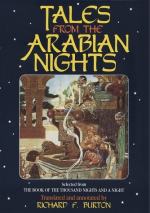Story of the Kazi Who Bare a Babe (pp. 130-144).
In the Esthonian Kalevipoeg we read of two giants who lay down to sleep on opposite sides of the table after eating a big supper of thick peas-soup. An unfortunate man was hidden under the table, and the consequence was that he was blown backwards and forwards between them all night.
History of the Bhang-Eater and His Wife (pp. 155-161).
Selling a bull or a cow in the manner described is a familiar incident in folk-lore; and in Riviere’s “Contes Populaires Kabyles” we find a variant of the present story under the title of “L’Idiot et le Coucou.” In another form, the cow or other article is exchanged for some worthless, or apparently worthless, commodity, as in Jack and the Bean-stalk; Hans im Gluck; or as in the case of Moses in the Vicar of Wakefield. The incident of the fool finding a treasure occurs in Cazotte’s story of Xailoun.[FN#642]
How Drummer Abu Kasim Became a Kazi (pp. 161-163).
I have heard an anecdote of a man who was sued for the value of a bond which he had given payable one day after the day of judgment. The judge ruled, “This is the day of judgment, and I order that the bill must be paid to-morrow!”
Story of the Kazi and His Slipper (pp. 163-165).
This story is well known in Europe, though not as forming part of The Nights. Mr. W. A. Clouston informs me that it first appeared in Cardonne’s “Melanges de litterature orientale” (Paris, 1770). Cf. Nights x. App. pp. 450 and 452.
History of the Third Larrikin (pp. 231-233).
Such mistakes must be very frequent. I remember once seeing a maid stoop down with a jug in her hand, when she knocked her head against the table. Some one sitting by, thinking it was the jug, observed, “Never mind, there’s nothing in it.”
Another time I was driving out in the country with a large party, and our host got out to walk across to another point. Presently he was missed, and they inquired, “Where is he?” There was a dog lying in the carriage, and one of the party looked round, and not seeing the dog, responded, “Why, where is the dog?”
Tale of the Fisherman and His Son (pp. 247-260).
The present story, though not very important in itself, is interesting as combining some of the features of three distinct classes of folk-tales. One of these is the anti-Jewish series, of which Grimm’s story of the Jew in the Bramble-Bush is one of the most typical examples. According to these tales, any villainy is justifiable, if perpetrated on a Jew. We find traces of this feeling even in Shakespeare, and to this day Shylock (notwithstanding the grievous wrongs which he had suffered at the hands of Christians) rarely gets much sympathy from modern readers, who quite overlook all the extenuating circumstances in his case.[FN#643] Nor do we always find the Jew famous for ’cuteness in folk-tales. This phase of his reputation is comparatively modern, and in the time of Horace, “Credat Judaeus” was a Roman proverb, which means, freely translated, “Nobody would be fool enough to believe it except a Jew.”




